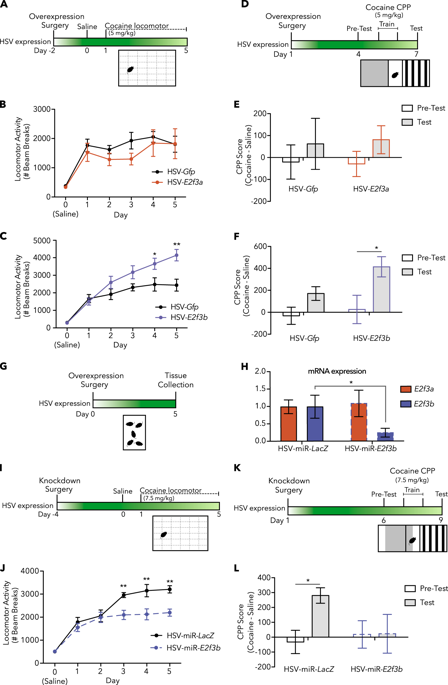当前位置:
X-MOL 学术
›
Neuropsychopharmacology
›
论文详情
Our official English website, www.x-mol.net, welcomes your
feedback! (Note: you will need to create a separate account there.)
A novel role for E2F3b in regulating cocaine action in the prefrontal cortex.
Neuropsychopharmacology ( IF 6.6 ) Pub Date : 2018-12-14 , DOI: 10.1038/s41386-018-0296-1 Hannah M Cates 1 , Rosemary C Bagot 1, 2 , Elizabeth A Heller 1, 3 , Immanuel Purushothaman 1 , Casey K Lardner 1 , Deena M Walker 1 , Catherine J Peña 1 , Rachael L Neve 4 , Li Shen 1 , Eric J Nestler 1
Neuropsychopharmacology ( IF 6.6 ) Pub Date : 2018-12-14 , DOI: 10.1038/s41386-018-0296-1 Hannah M Cates 1 , Rosemary C Bagot 1, 2 , Elizabeth A Heller 1, 3 , Immanuel Purushothaman 1 , Casey K Lardner 1 , Deena M Walker 1 , Catherine J Peña 1 , Rachael L Neve 4 , Li Shen 1 , Eric J Nestler 1
Affiliation

|
Drug abuse is a multifaceted disorder that involves maladaptive decision making. Long-lasting changes in the addicted brain are mediated by a complex circuit of brain reward regions. The prefrontal cortex (PFC) is one region in which chronic drug exposure changes expression and function of upstream transcriptional regulators to alter drug responses and aspects of the addicted phenotype. We reported recently that the transcription factor E2F3a is a critical mediator of cocaine responses in the nucleus accumbens. E2F3a is one of two splice variants of the E2f3 gene; the other is E2F3b. Another recent study predicted E2F3 as an upstream regulator of the transcriptional response to cocaine self-administration (SA) in PFC. Based on previous findings that E2F3a and E2F3b have divergent regulatory roles, we set out to study the putative transcriptional role of these transcripts in PFC in the context of repeated I.P. cocaine exposure. We implemented viral-mediated isoform-specific gene manipulation, RNA-sequencing, advanced bioinformatics analyses, and animal behavior to determine how E2F3a and E2F3b contribute to persistent cocaine-induced transcriptional changes in PFC. We show that E2F3b, but not E2F3a, in PFC is critical for cocaine locomotor and place preference behaviors. Interestingly, RNA-seq of PFC following E2f3b overexpression or I.P. cocaine exposure showed very different effects on expression levels of differentially expressed genes. However, we found that E2F3b drives a similar transcriptomic pattern to that of cocaine SA with overlapping upstream regulators and downstream pathways predicted. These findings reveal a novel transcriptional mechanism in PFC that controls behavioral and molecular responses to cocaine.
中文翻译:

E2F3b 在调节前额叶皮层可卡因作用中的新作用。
药物滥用是一种多方面的疾病,涉及不适应的决策。成瘾者大脑的持久变化是由大脑奖励区域的复杂回路介导的。前额叶皮层 (PFC) 是一个区域,其中慢性药物暴露会改变上游转录调节因子的表达和功能,从而改变药物反应和成瘾表型的各个方面。我们最近报道了转录因子 E2F3a 是伏隔核中可卡因反应的关键介质。E2F3a 是 E2f3 基因的两个剪接变体之一;另一个是E2F3b。最近的另一项研究预测 E2F3 是 PFC 中对可卡因自我给药 (SA) 的转录反应的上游调节因子。基于先前发现 E2F3a 和 E2F3b 具有不同的调节作用,我们开始研究在反复 IP 可卡因暴露的背景下这些转录物在 PFC 中的假定转录作用。我们实施了病毒介导的亚型特异性基因操作、RNA 测序、先进的生物信息学分析和动物行为,以确定 E2F3a 和 E2F3b 如何促进可卡因诱导的 PFC 持续性转录变化。我们表明,PFC 中的 E2F3b 而非 E2F3a 对可卡因运动和位置偏好行为至关重要。有趣的是,E2f3b 过表达或 IP 可卡因暴露后 PFC 的 RNA-seq 对差异表达基因的表达水平显示出非常不同的影响。然而,我们发现 E2F3b 驱动的转录组模式与可卡因 SA 的转录组模式相似,具有重叠的上游调节因子和预测的下游通路。
更新日期:2019-01-26
中文翻译:

E2F3b 在调节前额叶皮层可卡因作用中的新作用。
药物滥用是一种多方面的疾病,涉及不适应的决策。成瘾者大脑的持久变化是由大脑奖励区域的复杂回路介导的。前额叶皮层 (PFC) 是一个区域,其中慢性药物暴露会改变上游转录调节因子的表达和功能,从而改变药物反应和成瘾表型的各个方面。我们最近报道了转录因子 E2F3a 是伏隔核中可卡因反应的关键介质。E2F3a 是 E2f3 基因的两个剪接变体之一;另一个是E2F3b。最近的另一项研究预测 E2F3 是 PFC 中对可卡因自我给药 (SA) 的转录反应的上游调节因子。基于先前发现 E2F3a 和 E2F3b 具有不同的调节作用,我们开始研究在反复 IP 可卡因暴露的背景下这些转录物在 PFC 中的假定转录作用。我们实施了病毒介导的亚型特异性基因操作、RNA 测序、先进的生物信息学分析和动物行为,以确定 E2F3a 和 E2F3b 如何促进可卡因诱导的 PFC 持续性转录变化。我们表明,PFC 中的 E2F3b 而非 E2F3a 对可卡因运动和位置偏好行为至关重要。有趣的是,E2f3b 过表达或 IP 可卡因暴露后 PFC 的 RNA-seq 对差异表达基因的表达水平显示出非常不同的影响。然而,我们发现 E2F3b 驱动的转录组模式与可卡因 SA 的转录组模式相似,具有重叠的上游调节因子和预测的下游通路。











































 京公网安备 11010802027423号
京公网安备 11010802027423号